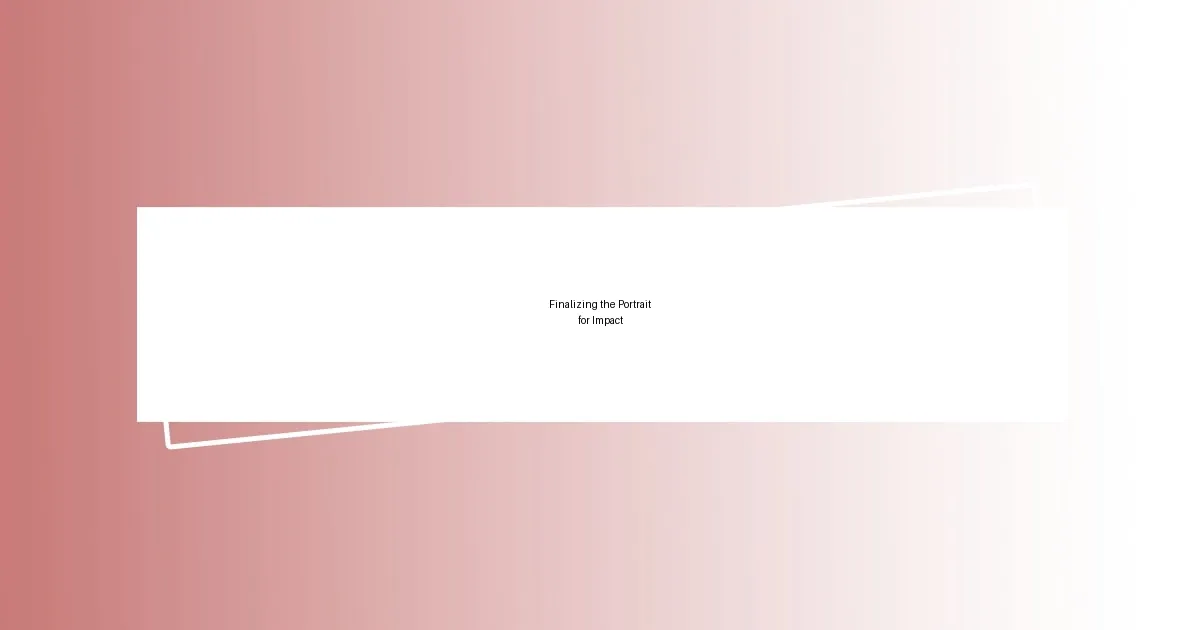Key takeaways:
- Performer portraits convey deep emotions and tell compelling stories through careful editing, including clarity, authentic representation, and thoughtful color usage.
- Effective lighting techniques, such as backlighting and diffusion, can significantly enhance the energy and essence of the portrait.
- Color correction is vital for evoking the right mood, balancing saturation, and leveraging shadow adjustments to add depth and detail to the images.
- Finalizing portraits with attention to details, smart cropping, and color grading greatly impacts the portrayal of the performer’s artistry and emotional expression.

Understanding Performer Portraits
When I first started diving into performer portraits, I realized that they serve as a powerful storytelling medium. Each portrait captures not just the physical appearance of the performer, but also their essence, emotions, and artistic vision. It makes me wonder—how can a single image evoke such a strong emotional response?
One memorable experience I had was attending a gallery exhibit dedicated to performer portraits. As I stood in front of a striking image of a dancer in mid-leap, I felt the energy and passion radiating from the photograph. It struck me that successful portraits don’t just freeze a moment in time; they convey the dynamism of performance and the soul of the artist. From an editing perspective, it’s fascinating how lighting, composition, and even post-processing can enhance these qualities, making each portrait come alive in its own way.
I often think about how a performer’s portrait can influence perceptions of their artistry. For instance, consider a jazz musician whose portrait reflects not just their style but the emotion behind their music. Does the image compel you to explore their work further? In my experience, the best portraits act as a gateway, inviting observers to connect on a deeper level with the performer’s journey.

Key Elements of Effective Edits
When editing performer portraits, clarity is vital. Clear images highlight the subject’s strengths, emphasizing their expressions and gestures. I once worked on a theater actor’s portrait where a sharp edit allowed his intense gaze to emerge, captivating anyone who glanced at the photo. In the world of performer portraits, it often strikes me how the smallest adjustments can shift focus and enhance storytelling.
Another key element is authentic representation. Edits should preserve the essence of the performer while enhancing their unique qualities. I remember editing a portrait of a street musician; I aimed to emphasize his individuality, capturing his passion while ensuring the context stayed true to his environment. This authenticity evokes emotions and resonates with viewers, making them feel connected to the subject.
Finally, the role of color cannot be overstated in effective edits. Different hues and contrasts set the mood, deeply influencing how we perceive a performer’s art. I often find that adjusting the saturation in a dancer’s portrait can either amplify their grace or lend a more dramatic tone to the image. Understanding color theory and how it impacts emotions can elevate a simple portrait into a compelling narrative.
| Key Element | Description |
|---|---|
| Clarity | Ensuring sharpness in the image to highlight the subject’s expressions and gestures. |
| Authentic Representation | Maintaining the essence of the performer while enhancing their unique qualities. |
| Color Usage | Utilizing color theory to influence mood and perception of the subject. |

Techniques for Enhancing Lighting
Lighting can truly transform a performer portrait, breathing life into the image. In my experience, strategic use of natural light can beautifully capture a performer’s essence. I once shot a band performing outdoors during golden hour; the warm sunlight not only highlighted their features but also created a vibrant, almost dreamlike atmosphere that resonated with their music. The artistry of lighting lies in its ability to evoke emotions and set the stage for storytelling.
To enhance lighting effectively, consider these techniques:
- Backlighting: Creates dramatic silhouettes and adds depth.
- Diffusion: Soften harsh light with a diffuser to produce more flattering highlights.
- Lighting Angles: Experimenting with different angles can reveal textures and features that define the performer.
- Spotlight Effects: Use focused light to draw attention to specific elements of a performance or portrait.
- Color Gels: Experimenting with colored filters can add a unique mood, aligning visually with the performer’s artistic style.
These techniques have become essential tools in my editing process, helping to craft portraits that reflect not just a moment, but the very soul of the performer.

Tips for Color Correction
Color correction is an art that requires an intuitive understanding of how colors interact. I remember a time when I was editing a portrait of a jazz singer, and the original colors felt flat and uninspired. After tweaking the warmth and enhancing the vibrancy, the image mirrored the vivacity of her performance. It made me realize how color adjustments can transform an entire mood, inviting viewers to feel the energy of the moment.
When working on color correction, I’ve found that a balanced approach is crucial. Too much saturation can overpower the subject, whereas too little can make them appear washed out. I often ask myself, “What do I want viewers to feel when they look at this portrait?” For instance, in an edit of a classical musician, I opted for softer hues to create a sense of elegance and calm, reflecting the gentle melody of the music.
Don’t forget about the shadows! I’ve had experiences where correcting the shadows added depth and drama to a performer’s portrait. Once, in working with a dramatic actress, adjusting the shadow tones revealed intricate details in her expression that were initially hidden. It was a simple correction, yet it made the image feel much more alive and engaging. Color correction isn’t just about technical adjustments; it’s about telling a story through the hues that resonate with the viewer.

Composing Engaging Backgrounds
Creating engaging backgrounds is crucial in elevating performer portraits. I recall an intimate gig where the backdrop was nothing but brick walls and dim lighting. Instead of keeping the focus solely on the performer, I decided to enhance those textures by capturing different angles. It turned out that the roughness of the bricks told a story of urban energy that mirrored the raw passion in the performer’s voice. Don’t you think a captivating background can really set the mood?
When I think about how to make backgrounds engaging, my mind often wanders to the importance of simplicity. A cluttered backdrop can distract from the focal point—the performer. During a photoshoot for a solo violinist, I opted for a gently blurred forest scene behind her. The soft hues of green and brown didn’t overpower her presence, but instead, they added a sense of tranquility, making the viewer feel as if they were part of a serene, magical moment. It’s funny how sometimes less truly is more.
Textures and colors play a pivotal role too. Once, I experimented with a colorful drapery behind a dancer, using bold reds and golds to accentuate her movements. The interplay of those hues enhanced the energy of her performance vividly. It sparked joy in the final image, drawing viewers in as if inviting them to experience the performance firsthand. How do you envision the backgrounds in your portraits enhancing the narrative?

Using Tools for Retouching
When it comes to retouching, the right tools can elevate a performer’s portrait from good to remarkable. I’ve recently been diving into a software that offers advanced healing brushes, and I must say, the precision is incredible. I recall a shoot with a singer whose makeup had smudged during an energetic performance. With just a few strokes, the healing brush restored her flawless look without compromising the authenticity of her expression. Have you ever found a tool that just felt like magic in the editing process?
During retouching, don’t underestimate the power of adjustment layers. They allow for non-destructive edits, meaning you can experiment without the fear of losing your original image. I remember working on a dynamic theater performance where vibrant stage lights cast intense colors on the performers. Using adjustment layers helped me fine-tune their skin tones while keeping that dramatic lighting intact. This flexibility made the final portrait pop with life while preserving the moment’s raw energy. How often do you find yourself wishing you could go back and tweak something you removed permanently?
I always stress the value of smart sharpening tools during the retouching phase. I had a personal experience when I edited a portrait of a contemporary dancer whose movements were fluid and graceful. I applied subtle sharpening to highlight her flowing attire and the delicate expressions in her face without making the image look harsh. The result was breathtaking, capturing not just her form but the essence of her dance. Isn’t it fascinating how the right retouching technique can hold a mirror to the emotion behind a performer’s art?

Finalizing the Portrait for Impact
When finalizing a portrait, I believe it’s essential to focus on the details that can make a significant impact. I once worked with a jazz musician who had the most expressive hands—each gesture telling a story. By highlighting those details in the final edit, I was able to capture not just his image but the very soul of his performance. Have you thought about what small elements could elevate your portraits to that next level?
Another critical aspect is the final color grading. I had an experience during a rock concert where deep, moody tones perfectly matched the singer’s heartfelt lyrics. Adjusting the saturation and contrast to enhance those rich reds and blacks brought a palpable intensity to the portrait. It’s amazing how a simple tweak can change the entire vibe. What colors resonate with the emotions you want to convey?
Lastly, the finishing touches, like cropping or adding a vignette, can create a striking focal point. I remember editing a portrait of a classical guitarist and decided to crop tightly, framing just his expression and hands against a softly blurred background. This approach directed the viewer’s attention precisely where I wanted it—on the passion and concentration in that moment. Don’t you think a well-placed crop can transform an image from ordinary to mesmerizing?














